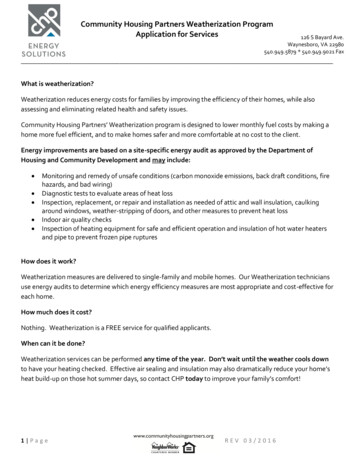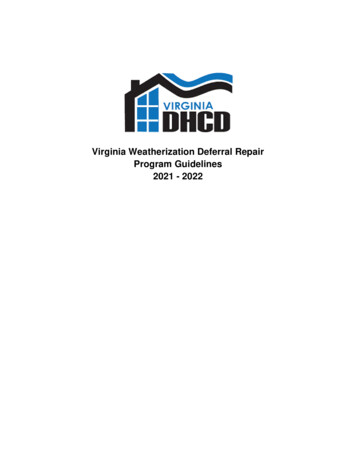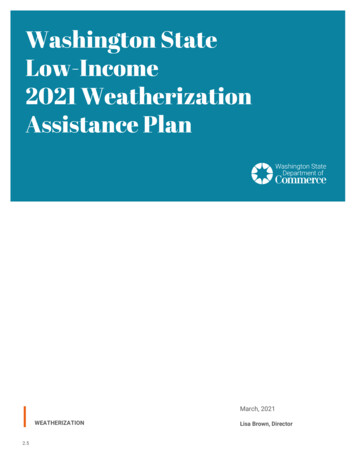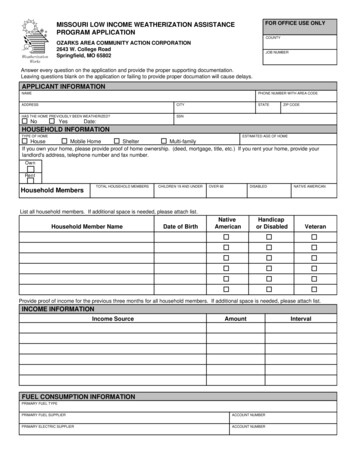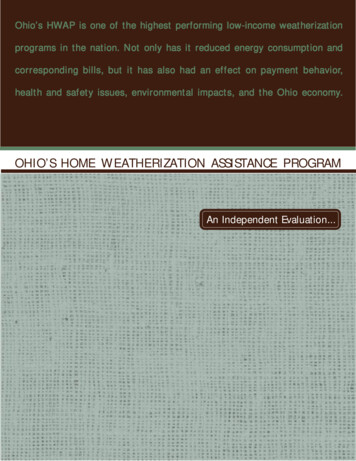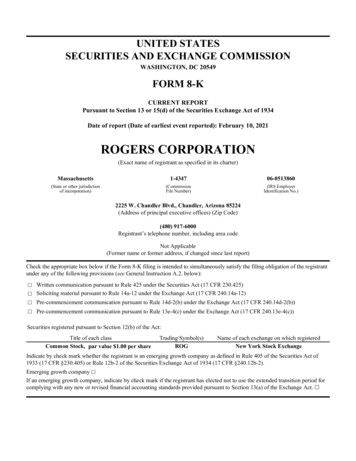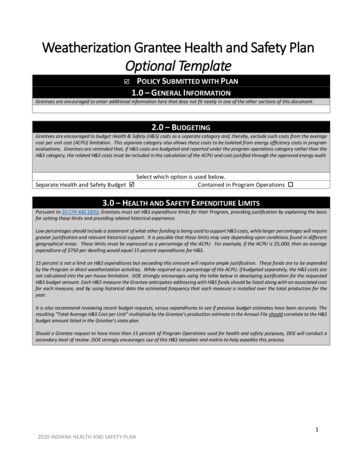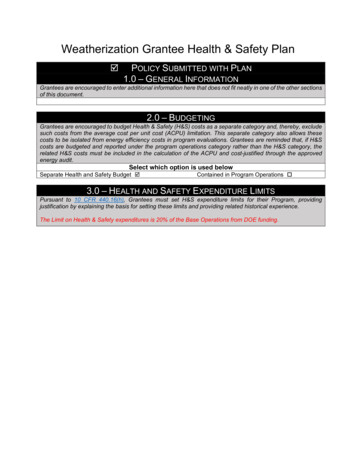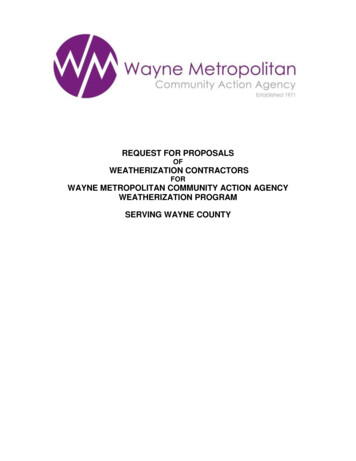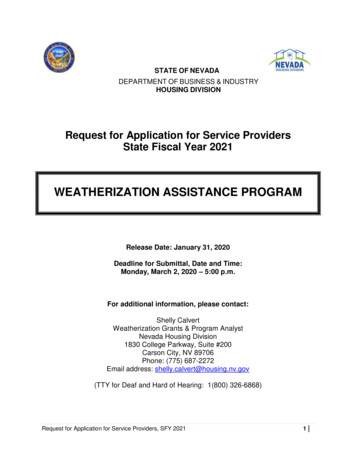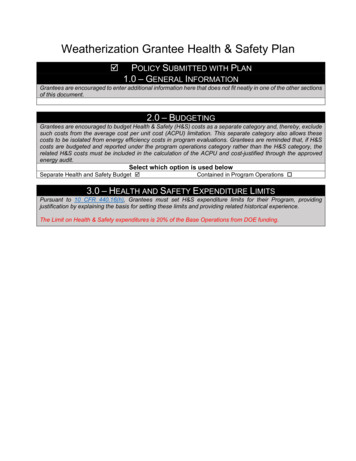
Transcription
Weatherization Grantee Health & Safety Plan POLICY SUBMITTED WITH PLAN1.0 – GENERAL INFORMATIONGrantees are encouraged to enter additional information here that does not fit neatly in one of the other sectionsof this document.2.0 – BUDGETINGGrantees are encouraged to budget Health & Safety (H&S) costs as a separate category and, thereby, excludesuch costs from the average cost per unit cost (ACPU) limitation. This separate category also allows thesecosts to be isolated from energy efficiency costs in program evaluations. Grantees are reminded that, if H&Scosts are budgeted and reported under the program operations category rather than the H&S category, therelated H&S costs must be included in the calculation of the ACPU and cost-justified through the approvedenergy audit.Select which option is used belowSeparate Health and Safety Budget Contained in Program Operations 3.0 – HEALTH AND SAFETY EXPENDITURE LIMITSPursuant to 10 CFR 440.16(h), Grantees must set H&S expenditure limits for their Program, providingjustification by explaining the basis for setting these limits and providing related historical experience.The Limit on Health & Safety expenditures is 20% of the Base Operations from DOE funding.
H&S Measure Matrix - OptionalDouble Click To Open For EditingCells this shade auto calculateEnter Frequency % Enter Cost Enter Measure Heating System Replacement 2,800.0010.0% 350.0040.0%Heating System RepairWater Heater Replacement 1,200.0020.0%Water Heater Repair 150.005.0%Smoke detector 25.0095.0%CO detector 55.0095.0%Minor Roof Repair 250.002.5%Code Compliance 85.005.0%Stove Repair 150.0010.0%Minor Gas Line Repair 100.0020.0%Minor Electrical Repair 150.0015.0%Minor Plumbing Repair 100.005.0%ASHRAE fan installation 620.0040.0%Lead-Safe Work Practices 170.0015.0%Asbestos Testing (in siding, walls, ceilings) 100.003.0%Vapor Barrier Installation 750.0025.0%Gas Appliance Vent Repair/Replacement 100.0037.5%Dehumidifer 225.005.0%Sump Pump 125.005.0%Hazardous Material Removal 100.002.0%Exhaust Fan Installation 90.0015.0%Total Average H&S Cost Per UnitEnter Estimated Production (Annual File: IV.2 WAP Production Schedule) Enter Estimated Program Operations Budget H&S Budget (Total Average H&S Cost Per Unit * Estimated Production)Requested H&S Percentage Per Unit (H&S Budget/Program Operations)Auto Calculates 280.00 140.00 240.00 7.50 23.75 52.25 6.25 4.25 15.00 20.00 22.50 5.00 248.00 25.50 3.00 187.50 37.50 11.25 6.25 2.00 13.50 1,351.007475,043,781 1,009,197.0020.0%Note: In the State Plan, Indiana lists the Health and Safety budget as 1,145,699.69. This is based onthe 2019-2020 Program Year and includes carryover.
4.0 – INCIDENTAL REPAIR MEASURESIf Grantees choose to identify any H&S measures as incidental repair measures (IRMs), they must beimplemented as such under the Grantee’s weatherization program in all cases – meaning, they can never beapplied to the H&S budget category. In order to be considered IRMs, the measure must fit the followingdefinition and be cost justified along with the associated efficiency measure. Incidental Repairs means thoserepairs necessary for the effective performance or preservation of weatherization materials. Such repairsinclude, but are not limited to, framing or repairing windows and doors which could not otherwise be caulked orweather-stripped and providing protective materials, such as paint, used to seal materials installed under thisprogram. 10 CFR 440.(1) Source control (i.e. correction of moisture and mold creating conditions) is allowed when necessary inorder to weatherize the home and to ensure the long-term stability and durability of the measures. Somemeasures that address source control may include, but are not limited to: drainage, gutters, down spouts,extensions, flashing, sump pumps, dehumidifiers, landscaping, leaking roofs, etc. These measures arenecessary for the effective performance or preservation of weatherization materials. If the home requires the installation or repair of a moisture barrier, drainage, flashing, sump pump,gutters, downspouts, extensions, flashing, dehumidifiers, or landscaping to ensure the insulation inthe crawlspace or sidewalls remains fully intact, the cost of installing the barrier can be included as anecessary cost as a result of installing the insulation. If no insulation is being installed in thecrawlspace and any of these items serve to prevent mold and moisture growth alone, this measure isconsidered a H&S cost. All IRM’s costs must be justified using a NEAT/MHEA/MulTEA audit. If the home requires the repair of a roof leak in order to protect insulation installed in the attic orsidewalls of the home, the cost can be considered an IRM.(2) A vapor or moisture barrier may be installed as either a H&S cost, or as an IRM to air sealing measures ifthe cost is justified as part of NEAT audit. Otherwise, this is a H&S cost.(3) The installation of an ASHRAE fan may not be considered as an IRM to air sealing measures. ASHRAEfans must be considered an H&S cost.(4) Minor Electrical Repairs, including the repair or replacement of knob and tube wiring, may be consideredincidental repairs when associated with the installation and preservation of insulation in the attic or sidewalls.Otherwise, this is a H&S cost.(5) Lead-Safe Work Practices may be considered an incidental repair when considering the ECM of insulatingthe sidewalls of a home. Otherwise, this is a H&S cost.(6) Window and door repair, replacement, or installation is not an allowable H&S cost. These can beconsidered an ECM or IRM. Window or door air sealing can be an ECM, IRM, or H&S cost.(7) Venting System Replacement: This can be considered an IRM of the ECM of replacing a heating system.Otherwise, this is a H&S cost.(8) Ductwork Repair / Replacement: This can be considered an IRM of the ECM of replacing a heatingsystem. Otherwise, this is a H&S cost.(9) The installation of a chimney liner for an orphaned water heater may be considered as an IRM of the ECMof repairing or replacing a heating system. Otherwise, this is a H&S cost.(10) Intumescent coating may be considered as an IRM of the ECM of two component foam. Otherwise it canbe a H&S cost.(11) A/C system can be repaired or replaced as an IRM when it would protect an installed ECM. A/C systemrepair or replacement may utilize H&S funding when documented medical justification by a physician is in thefile. All A/C units must be evaluated as an ECM prior to utilizing H&S.Deferral of services may be necessary if H&S issues cannot be adequately addressed according to WPN 22-7guidance. The decision to defer work in a dwelling is difficult but necessary in some cases. This does not meanthat assistance will never be available, but that work must be postponed until the problems can be resolvedand/or alternative sources of help are found. If, in the judgment of the auditor, any conditions exist which mayendanger the health and/or safety of the workers or occupants, the unit should be deferred until the conditionsare corrected. Deferral may also be necessary where occupants are uncooperative, abusive, or threatening.Grantees must be specific in their approach and provide the process for clients to be notified in writing of thedeferral and what conditions must be met for weatherization to continue. Grantees must also provide a processfor the client to appeal the deferral decision to a higher level in the organization.
Grantee has developed a comprehensive written deferral/referral policy that covers bothH&S, and other deferral reasons?Yes No Where can this deferral/referral policy be accessed?See Appendix AA – Deferral Program at MyIHCDA’s Weatherization7.0 – HEALTH AND SAFETY CATEGORIESFor each of the following H&S categories identified by DOE: Explain whether you concur with existing guidance from WPN 22-7 and how that guidance will beimplemented in your Program, if you are proposing an alternative action/allowability, or if the identifiedcategory will not be addressed and will always result in deferral. Alternatives must be comprehensivelyexplained and meet the intent of DOE guidance. Where an Action/Allowability or Testing is “required” or “not allowed” through WPN 22-7, Granteesmust concur, or choose to defer all units where the specific category is encountered. “Allowable” items under WPN 22-7 leave room for Grantees to determine if the category, or testing,will be addressed and in what circumstances Declare whether DOE funds or alternate funding source(s) will be used to address the particularcategory Describe the explicit methods to remedy the specific category Describe what testing protocols (if any) will be used Define minimum thresholds that determine minor and major repairs Identify minimum documentation requirements for at-risk occupants Discuss what explicit steps will be taken to educate the client, if any, on the specific category if this isnot explained elsewhere in the Plan. Some categories, like mold and moisture, require clienteducation. Discuss how training and certification requirements will be provided for the specific category. Somecategories, like Lead Based Paint, require training. Describe how occupant health and safety concerns and conditions will be solicited and documentedGrantees may include additional H&S categories for their particular Programs. Additional categories mustinclude, at a minimum, all of the same data fields as the DOE-provided categories. Two additional tables havebeen created to utilize.
7.1 – Air Conditioning and Heating SystemsConcurrence, Alternative, or DeferralConcurrence with Guidance Alternative Guidance Results in Deferral Air Conditioning Unallowable Measure Heating Unallowable Measure DOE LIHEAP FundingState Utility Other How do you address unsafe or non-functioning primary heating/cooling systems?If the heating system is operable, the system must be run through NEAT/MHEA/MulTEA first to determine if itis allowable to be replaced as an energy conservation measure. "Red tagged," inoperable or nonexistentheating system replacement, repair, or installation is allowed with DOE funds and LIHEAP funds. Repairs tooutside units is generally not allowable. Repairs can be charged as DOE Health and Safety cost or LIHEAPMechanical cost. The subgrantee must first determine whether repairs can effectively be made to the heatingsystem to enable it to operate safely, rather than require a replacement.Sub-grantees are allowed to replace heating systems in the following circumstances: A verifiable condition exists that allows combustion gases to enter the living environment. Forexample, a breach in the heat exchanger that allows combustion gases to mix with the air in theductwork. An improper application of a non-sealed combustion furnace installed in a manufactured home.Manufactured homes are required to have furnaces that draw their combustion air from outside thecarriage. All new furnace installations in manufactured homes must be approved for use inmanufactured housing. Heating systems can be replaced when the NEAT, MHEA, or MulTEA audit shows the replacementto meet an SIR of 1 or greater. Subgrantees must run a NEAT/MHEA/MulTEA audit when DOEfunding is used to pay for a furnace replacement. The NEAT/MHEA/MulTEA work scope must befollowed once a NEAT/MHEA/MulTEA audit has been performed on a structure. The cost of necessary repairs will exceed 50% of the cost of replacing the heating system. Replacement parts are no longer produced or available. If the fuel source is no longer available to the client, the Subgrantee must submit a request to IHCDArequesting the change of the fuel source and heating system, and requests will be evaluated on acase-by-case basis. New HVAC system selection must comply with SWSThe subgrantee may not continue with weatherization work, particularly air sealing the structure until thecombustion gases have been appropriately vented away from the living area.Before an HVAC system is installed in a unit, a Manual J must be completed. NEAT/MHEA/MulTEA is notapproved heat load calculation tools.HVAC system replacements in Indiana’s Weatherization Assistance Program are justified by utilizingIndiana's Heating Degree Days; the lower one-third of the state has a range of 4000 – 5499, and 5500 –7000 for the upper two-thirds of the State. This climatic information is incorporated into Indiana’s NEAT,MHEA, and MulTEA runs.
How do you address unsafe or non-functioning secondary heating systems, Includingunvented secondary space heaters?Unsafe secondary units, including space heaters must be removed, rendered inoperable, or the home mustbe deferred.Following WPN 22-7, secondary unvented units that conform to the safety standards of ANSI Z21.11.2 mayremain as back-up heat sources. DOE is allowing this flexibility primarily to provide low-income clients anemergency back-up source of heat in the event of electrical power outages. To leave a secondary unitbehind as a secondary source of heat, the unit must pass the IHCDA Unvented Space Heater Inspection andbe properly documented on the form.Secondary unvented units that do not meet ANSI Z21.11.2 must be removed and properly disposed of priorto weatherization but may remain until a replacement heating system is in place. Repair of secondaryunvented units is not allowed. Secondary unvented units that meet the ANSI Z21.11.2, but are not operatingsafely, must be removed and properly disposed of.An unvented gas- or liquid-fueled space heaters that remain after weatherization shall: Not have an input rating in excess of 40,000 Btu/hour Not be located in, or obtain combustion air from sleeping rooms, bathrooms, toilet rooms, or storageclosetsIHCDA does not permit any DOE-funded weatherization work on electric space heaters. Repair,replacement, or installation of electric standalone space heaters is not allowed. Removal of these spaceheaters is recommended. The energy auditor is required to perform a complete evaluation of the heatingsystem on each unit weatherized. Part of this evaluation will be determining what modifications orreplacements are required. Stand-alone electric heaters cannot be left in place as a client’s sole source ofheat. If provisions cannot be made for the installation of a permanent heating source, the home must bedeferred. In instances where a new heating system is installed, the client will be educated on the new heatingsystem and advised against using the stand-alone electric space heater. Should the stand-alone electricspace heater be found to be unsafe for use in the client’s home, it must be removed from use prior toweatherization proceeding.Unvented gas- or liquid-fueled space heaters must be removed and properly disposed of prior toweatherization in manufactured homes.Indicate Documentation Required for At-Risk OccupantsAuditors determine and document presence of “at-risk” current occupants when installing any Health andSafety measure. Sub-grantees are required to complete the Occupant Health Screening Form.
Testing ProtocolsHealth and safety inspections ensure that systems are present, operable, and performing. The health andsafety inspection of combustion appliances, including heating systems, includes the following items, but arenot limited to: The rated and measured BTU input of each combustion appliance A complete electrical inspection of the furnace including proper grounding, polarity, wiringconnections, fuse type and size, element amperage (electrical furnace), disconnect requirementsand conduit requirements An inspection of all fuel lines in the home from the source to the combustion appliance or linetermination. This includes all fittings, connections, shut-off valves, gas valves, sediment traps andend caps An inspection for spillage and a reading of the draft of gas/oil furnaces and water heaters(Completion of the appropriate Inspection Form) A visual check for flame interference A test of the setting and operation of the high limit control switch An evaluation of the adequacy of combustion air for combustion appliances A check that there are no open return air ducts/leaks in the Combustion Appliance Zone Carbon monoxide testing of all combustion appliances An inspection, and replacement if necessary, of the furnace filter Worst case CAZ depressurization and Indiana Daily Safety Test-Out Form Client EducationWhen deferral is necessary, provide information to the client, in writing, describing conditions thatmust be met in order for weatherization to commence. A copy of this notification must also be placedin the client file.Discuss appropriate use and maintenance of units.Provide all paperwork and manuals for any installed equipment.Discuss and provide information on proper disposal of bulk fuel tanks when not removed as part ofthe weatherization work.Where combustion equipment is present, provide safety information including how to recognizedepressurization.TrainingWAP Health and Safety policy training on allowable activities.Licensing and/or certification for HVAC installers as required by authority having jurisdiction (AHJ).CAZ depressurization test and inspection training.
7.2 - Asbestos - AllWhat is the blower door testing policy when suspected Asbestos Containing Material (ACM)is identified?Weatherization workers must recognize materials that may contain asbestos and avoid disturbing them. PerWPN 22-7, Subgrantees must not perform a blower door depressurization test in a building where friableasbestos, suspected asbestos containing insulation or vermiculite are present. Unless the suspect materialhas tested negative for asbestos, a blower door pressurization test must be performed, and must bedocumented in the client file. When suspected asbestos containing materials are present, assume that asbestos is present unlesstesting has determined otherwise. Asbestos Hazard Emergency Response Act of 1986 (AHERA) sample collection and testing must beconducted by a certified asbestos control professional. Baseline environmental asbestos sampling is an allowable H&S cost. Instruct clients in writing not to disturb suspected ACM. AHERA or other appropriate asbestos control professional certification/training is required to abateACM. AHERA or other appropriate asbestos control professional certification/training is required forencapsulation. If the Subgrantee has deferred a home which then results in the owner facilitates removal ofasbestos containing materials, it is required that the proper documentation validating removal wascompleted by a trained asbestos professional be provided to the Subgrantee prior to allowingweatherization services to move forward.7.2b – Asbestos - in vermiculiteConcurrence with Guidance DOE Concurrence, Alternative, or DeferralLIHEAP Alternative Guidance FundingState Utility Results in Deferral Other How do you address suspected ACM’s in vermiculite that will be disturbed through thecourse of weatherization work?If vermiculite insulation is found in a unit and that vermiculite insulation will require disturbance in order tocomplete weatherization activities, then the vermiculite insulation must either: Be tested by an AHERA professional to determine if asbestos is present or Must be assumed to contain asbestos.If it is tested and the results are positive, then either (a) the ACM must be removed in accordance with WPN22-7 guidance prior to weatherization activities commencing or (b) the home must be deferred until the ACMcan be removed in accordance with WPN 22-7. When vermiculite is present, and it is determined that testing will be completed testing is required byan AHERA or other appropriate asbestos control professional. If asbestos is present, the home must be able to be weatherized without asbestos disturbance. If itcan’t, then it must be deferred. Do not perform a blower door depressurization test. A blower door pressurization test is allowable. Use proper respiratory protection while in areas containing vermiculite. Encapsulation by an appropriately trained asbestos control professional is allowed. Removal is not an allowable cost. When deferral is necessary due to asbestos, occupant must provide documentation that a certifiedprofessional performed the remediation before work continues.
7.2c – Asbestos - on pipes, furnaces, other small, covered surfacesConcurrence with Guidance DOE Concurrence, Alternative, or DeferralAlternative Guidance LIHEAP FundingState Utility Results in Deferral Other How do you address suspected ACM’s (e.g., pipes, furnaces, other small surfaces) that willbe disturbed through the course of weatherization work? Assume asbestos is present in suspect covering materials.When suspected friable ACM is present, take precautionary measures as if it is asbestos unlesstesting determines otherwise.Encapsulation by an appropriately trained asbestos control professional is allowed and may beconducted prior to blower door testing if the materials are friable.Subgrantee may be allowed to remove by an appropriately trained professional on a case-by-casebasis.Grantees must state in the H&S Plan what criteria the Grantee uses when reviewing requests.Charge only those costs directly associated with the testing, encapsulation, or removal to the H&Sbudget category.When deferral is necessary due to asbestos, occupant must provide documentation that a certifiedprofessional performed the remediation before work continues.Testing Protocols Assess whether suspected ACMs are present.AHERA sample collection and testing is allowed and must be conducted by a certified tester. Instruct clients in writing not to disturb suspected ACM.Provide asbestos safety information to the client.Formally notify client in writing of results if testing was performed.When deferral is necessary, provide information in writing describing conditions that must be met inorder for weatherization to commence. How to recognize suspected ACM.AHERA or other appropriate asbestos control professional certification/training is required to abatethe ACM.Client EducationTraining and Certification Requirements7.5 – Biologicals and Unsanitary Conditions(odors, mustiness, bacteria, viruses, raw sewage, rotting wood, etc.)Concurrence with Guidance DOE Concurrence, Alternative, or DeferralLIHEAP Alternative Guidance Unallowable Measure FundingState Utility Results in Deferral Other What guidance do you provide Subgrantees for dealing with biological and/or unsanitaryconditions in homes slated for weatherization? Remediation of conditions that may lead to or promote biological concerns and unsanitary conditionsis allowed.Addressing bacteria and viruses is not an allowable cost.Deferral may be necessary in cases where conditions in the home pose a health risk to occupantsand/or weatherization workers.
Client EducationThe designated weatherization professional will inform the client, in writing, of observed conditions. Auditorswill provide information on how to maintain a sanitary home and steps to correct deferral conditions. Whendeferral is necessary, provide information in writing describing conditions that must be met for Weatherizationto commence.TrainingWeatherization Professionals receive training on how to recognize biological and unsanitary conditions andwhen those conditions are cause for deferral. Auditors are also trained in worker safety when coming intocontact with biological and unsanitary conditions. All weatherization professionals are required to haveinfectious disease training.7.6 – Building Structure and RoofingConcurrence with Guidance DOE Concurrence, Alternative, or DeferralLIHEAP Alternative Guidance FundingState Results in Deferral Utility Other What guidance do you provide Subgrantees for dealing with structural issues (e.g., roofing,wall, foundation) in homes slated for weatherization? Building rehabilitation is beyond the scope of the Weatherization Assistance Program.Homes that require more than minor repairs must be deferred. Minor repairs and installation may be conducted only when the H&S of the occupant/worker(s) is atrisk, or necessary to effectively weatherize the home; otherwise, these measures are not allowed.Allowable or “minor” structural and roofing repairs are considered as either H&S repair costs, orincluded as Incidental repairs.How do you define “minor” or allowable structure and roofing repairs, and at what point arerepairs considered beyond the scope of weatherization? At what point is a site-specific audit required?A NEAT/MHEA/MulTEA run is required to justify the all IRM’s. Client EducationNotify client in writing of structurally compromised areas.When deferral is necessary, provide information in writing describing conditions that must be met inorder for weatherization to commence.TrainingAuditors are trained how to identify structural and roofing issues.
7.7 – Code ComplianceConcurrence with Guidance DOE Concurrence, Alternative, or DeferralAlternative Guidance LIHEAP FundingState Utility Results in Deferral Other What guidance do you provide Subgrantees for dealing with code compliance issues inhomes receiving weatherization measures? Correction of preexisting code compliance issues is not an allowable cost unless triggered byweatherization measures being installed in a specific room or area of the home.When correction of preexisting code compliance issues is triggered, and paid for with WAP funds,document specific code requirements with reference to the weatherization measure(s) thattriggered the code compliance issue in the client file.Follow State and local or AHJ codes while installing weatherization measures, including H&Smeasures.Condemned properties or dwellings where H&S conditions exist that cannot be corrected under thisguidance must be deferred.What specific situations commonly trigger code compliance work requirements for yournetwork? How are they addressed?The following examples commonly trigger code compliance work requirements in Indiana: Expansion tank installation for newly installed water heaters is a common code compliance issue. A wire splice is not in a junction box.In every case of code compliance, Indiana indicates that the local code requirement is the AHJ, and if it isdetermined that the code compliance issue cannot be resolved using traditional weatherization funds, thehome must be deferred. Client EducationInform client in writing of observed code compliance issues when it results in a deferral.When deferral is necessary, provide information in writing describing conditions that must be met inorder for weatherization to commence.TrainingAuditors, QCIs, and contractors are all instructed how to determine what code compliance may be required.7.8 – Combustion GasesConcurrence with Guidance DOE Concurrence, Alternative, or DeferralLIHEAP Alternative Guidance FundingState Utility Testing ProtocolsResults in Deferral Other Health and safety inspections ensure that systems are present, operable, and performing. The health andsafety inspection of combustion appliances, include but are not limited to the following items: Combustion safety testing is required when combustion appliances are present Test naturally drafting appliances for spillage and CO during CAZ depressurization testing pre- andpost-weatherization and before leaving the home on any day when work has been done that couldaffect draft (e.g., tightening the home, adding exhaust) Inspect venting of combustion appliances and confirm adequate clearances Utilize the NEAT/MHEA/MulTEA audit to determine if the appliance can be justified as an ECM priorto replacement as an H&S measureClient EducationClients will be provided with combustion safety and hazards information, including the importance of usingexhaust ventilation when cooking and the importance of keeping burners clean to limit the production of CO.
TrainingTraining will be provided on the following: How to perform appropriate testing, determine when a building is excessively depressurized, and thedifference between air free and as-measured CO. CO action levels.7.9 – ElectricalConcurrence with Guidance DOE Concurrence, Alternative, or DeferralLIHEAP Alternative Guidance FundingState Utility Results in Deferral Other What guidance do you provide Subgrantees for dealing with electrical hazards, includingknob & tube wiring, in homes slated for weatherization?The guidance provided is to follow the SWS, Indiana Field Guide, and the National Electric Code (NEC).Per the electrical inspection section of the SWS-Aligned Indiana Weatherization Field Guide, auditors identifyany knob and tube wiring found in the dwelling and test it to see if it is live. Live knob and tube wiring cannever be covered by insulation as a result of any weatherization measure. Damming of knob and tube wiringprior to insulation is acceptable. Existing insulation covering live knob and tube shall not be removed. Norshall additional insulation be added above the knob and tube. Inspect for the presence and condition of knoband-tube wiring and check for alterations that might create an electrical hazard. If knob-and-tube integrity isquestionable, have it inspected by an electrician.How do you define “minor” or allowable electrical repairs, and at what point are repairsconsidered beyond the scope of weatherization? Minor repairs are generally defined as, but not limited to, the following: Installation of junction boxes,installation of junction box covers, flagging of junction boxes, replacement of broken outlets andswitches, etc.The replacement of Installing a new electrical panel, new incoming service or completely rewiring ahome are not considered minor electrical repairs.Knob and Tube wiring may be replaced as an Incidental Repair.If repairs are designated as Incidental Repairs, at what point is a site-specific auditrequired?NEAT/MHEA/MulTEA must be run for all homes.Client Edu
(9) The installation of a chimney liner for an orphaned water heater may be considered as an IRM of the ECM of repairing or replacing a heating system. Otherwise, this is a H&S cost. (10) Intumescent coating may be considered as an IRM of the ECM of two component foam. Otherwise it can be a H&S cost.
